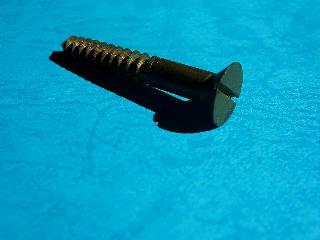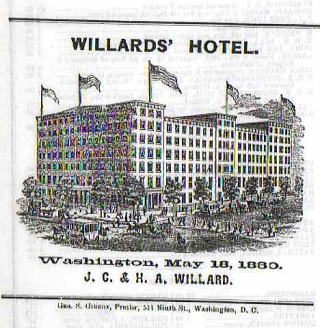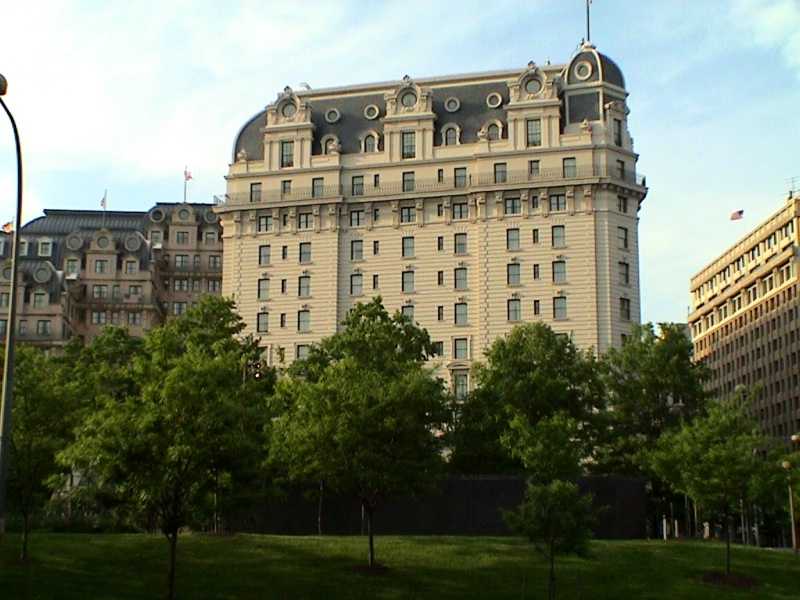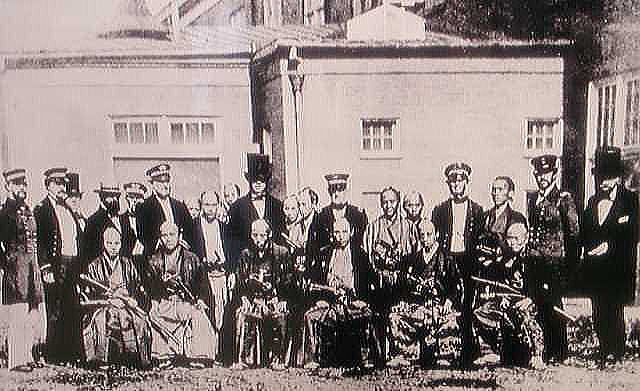「幕府政治は無知蒙昧・遅れていた政治」、という明治以来の洗脳は今もつづく
遣米使節の業績を低く評価
■ 勝海舟をワシントンに登場させたNHK大河ドラマ『いだてん』
2019平成31年2月10日第6回放映の場面、嘉納治五郎が金栗四三に語りかけるシーンで上記の「ワシントン海軍造船所見学」画像を流し、画像にかぶせて
『かの勝海舟先生が、日米修好通商条約を結ぶに際しアメリカに渡ったとき、日本人の使者はちょん髷に羽織袴、腰には刀を差していた。そりゃあ山猿と笑われただろう。たかだか50年前の話だよ……』
と嘉納が語って笑いものの例にしている。
問題点
1,いまだに「勝海舟が遣米使節、という錯覚」の勝海舟神話に惑わされ、そのまま堂々と放映しているNHK。これで「勝海舟がワシントンに行った」と錯覚する日本人がまた増えたことだろう。
2,この見学を契機として小栗上野介が帰国後に提議し、建設された横須賀造船所が日本産業革命の地となったことを知らないまま、この記念写真を「山猿の日本人」の例として貶おとしめている。
司馬遼太郎はこの記念写真で堂々とした気品をあらわしている武士たちの姿をたたえ、ついでに明治5年の岩倉米欧使節団の写真を「品下がる」と一言で切り捨てている。「成り上がり者、品がない」ということ。
The brainwashing since the Meiji era
that "Shogunate politics was ignorant and behind the times" continues to this day.
Low evaluation of the achievements of the Japanese Mission to the U.S. |
■ NHK's historical drama "Idaten," which mistakenly featured Kaishu Katsu in Washington, D.C.
In the scene of the 6th episode aired on February 10, 2019, with the above image of the "Washington Naval Shipyard Tour" at the back, Jigoro Kano said the following to Shizo Kanakuri as an example of a laughingstock:
"When Kaishu Katsu went to the United States to sign the Japan-U.S. Treaty of Amity and Commerce, the Japanese envoys wore topknots and haori hakamas with swords at their waists. They were probably laughed at as mountain monkeyd. It was only 50 years ago...."
Problems:
1. NHK is still fooled by the myth of Kaishu Katsu, and is still showing the story as it is, with the illusion that Kaishu Katsu was an envoy to the U.S. This scene must have increased the number of Japanese who think that Kaishu Katsu went to Washington D.C.
2. NHK disparaged this commemorative photo as an example of "Japanese mountain monkeys," without knowing that this visit to the Naval Yard led to the Yokosuka Shipyard, which Kozukenosuke Oguri proposed to build after returning to Japan, and Yokosuka became the site of Japan's industrial revolution.
Ryotaro Shiba praised the samurais in this commemorative photo for their dignified elegance, while he dismissed the photograph of the Iwakura Mission to the United States and Europe in 1872 with a single word, "low class," meaning they are upstarts and have no style."
■遣米使節団の業績を矮小(わいしょう)化する学者
◇ 明治以後の歴史書・教科書はこの大事な写真を無視するか、せいぜい「ワシントン上陸後の記念写真」ていどの扱いですませてきた。それは明治以来150年間の学校教育において、幕府政治は遅れた封建政治―日本を近代化したのは明治政府、とする幕府政治否定教育を基本としてきたからであろう。その風潮は今も続いていて、たとえば次のように「ただの観光旅行」と評する歴史家がいたりする。
◇「ただの観光旅行」
「川路(聖謨)、岩瀬(忠震))、永井(玄蕃)が行っていれば、もう少し新しい何かを収穫して帰ったであろうのに、新見(正興)、村垣(範正)、小栗では、ただの観光旅行になってしまった」(勝部真長著『勝海舟』PHP出版・平成4年) *勝部氏はお茶の水女子大学名誉教授
■ There are scholars who trivialize the achievements of the mission to the United States.
◇ History books and textbooks since the Meiji era have either ignored this important photo or treated it as a "commemorative photo of the landing in Washington D.C." at best. This is probably due to the fact that for the past 150 years since the Meiji era, school education has been based on the denial of shogunate politics, believing that shogunate politics were feudalistic and that it was the Meiji government that modernized Japan. This trend continues to this day, with some historians describing it as "just a sightseeing trip."
◇ A historian calls it "just a sightseeing trip."
"If Toshiakira Kawaji, Tadanari Iwase, and Gemba Nagai had visited the U.S., they would have returned with something new, but with Masaoki Shinmi, Norimasa Muragaki, and Tadamasa Oguri, it was just a sightseeing trip.
("Kaishu Katsu," by Mitake Katsube, PHP Publishing, 1992) *Mr. Katsube is a professor emeritus at Ochanomizu University.)
◇徳富蘇峰の次の文章が矮小評価の始まり
アメリカ側は使節一行に、
ボストンなどほかの都市でも来訪を期待しているから訪問し、さらにはロンドンやパリまでも船で送るからと訪ねることをしきりに勧めた。
しかし、使節らがそれを断って帰国したことを非難して徳富蘇峰は次のように書く。
「華盛頓ワシントン市中は勿論、合衆国の諸部落はいづれ成共なりとも、御覧ごらん御座候ござそうろう事差支さしつかえこれ無く候間そうろうあいだ、御都合次第御案内申上候。御見物行はせらるべく候。
と彼方かなたから申し入れている。さればこれは全く彼方の好意といわねばならぬ。もちろん各地においては、ただ珍客として、その好奇心に駆られたるの歓迎であったとはいえ、さればかれらはすべからくこの見学を十二分になし遂ぐべきであった。しかるに彼らがせっかくの好意を、かく面倒そうに断ったのは何故であろう。もし新見・村垣の代わりに、岩瀬などが来たらば、恐らくは此方こなたよりどしどし押し出して見学の利をあくまで取得したであろう。」(徳富蘇峰『遣米使節と露英対決篇』)
◇ The words of Soho Tokutomi is the beginning of the diminutive evaluation of the Mission
The Americans insisted that the delegation visit other cities, such as Boston, because they were expecting their visit, and that they would be sent by ship even to London and Parisl. However, the envoys refused and returned home. In condemnation of this, Soho Tokutomi wrote as follows:
"You are welcome to visit the city of Washington, or any city in the United States. We'll let you know when you're ready. We would be happy to show you around."
The Americans told the above to the delegation. This must have been a sheer goodwill from them. Of course, in many places, they were welcomed only as rare guests, driven by their curiosity, but they should have been more than able to complete the tour. Why, then, did they turn down such a kind offer in such a troublesome manner? If Iwase and others had come instead of Shinmi and Muragaki, they probably would have been more willing to take full advantage of the visit.
(“The Mission to the U.S. and the Russo-British Confrontation” by Soho Tokutomi)
◇ 帰国を急ぐのは武士だから
遣米使節に代って代弁すれば、この時の使節一行の心情としては、徳川幕府始まって以来はじめての正式な遣外使節の派遣であるから、
「素もとより使節の任はてければ、とく帰りて復命をいそぎ、鎖国を開きて初はじめての航海なれば、我わが大君をはじめ、国人心安からねば、帰程を急げるとてさまざまに断りけるが…」(村垣範正『遣米使日記』)
…とあるように、
1,批准書交換の任務が済んだ以上、一日も早く帰国して報告するのが武士の心がけの基本…出張にかこつけてついでに物見遊山してくる明治以後の官僚や政治家の感覚で捉えてはいけない。
2,初めての遣外使節で、無事帰国を心配しているであろう幕府や留守家族を安心させたい…幕末から始まった庶民の海外渡航は誰もが命がけの旅に出るイメージで捉えて横浜港まで見送りに行き、互いに紙テープを握って別れを惜しみ、戦後も家族友人知人が羽田空港まで見送りに行くことが普通で、その風潮は昭和40年代の「海外渡航自由化」後もしばらく続いた。「農協観光」が海外に行くようになって羽田空港の見送り風景は消えた。
3,攘夷の風潮が激しい日本に帰るのであるから、任務が終わったあとあちこちを物見遊山して来たと取られることは以後の対外国交渉において攘夷派からどんな妨げを受けるかしれない。
…これが当時の武士の心情であろう。
事実、帰国した使節に対して、ボルチモアやフィラデルフィア、ニューヨークを経由してきたことすらも「物見遊山してきた」、と非難する声があったという。
◇ 徳富は上記の前段で小栗上野介に対しては
「この一行にもし岩瀬があったならば、いかに多大の獲物を携たずさえて帰朝したであろうかと思わるるが、新見・村垣の両副使は、別段それほどの獲物も齎もたらし来たったとは思われなかった。ただその目付として同行したる小栗忠順に到りては、じつにその人を得たるものにして、彼はこの十ケ月間の旅行中、その見聞より得たるところ、すこぶる多大であったであろう。」(徳富蘇峰『遣米使節と露英対決篇』)
…と岩瀬忠震ただなりを評価し、小栗上野介に一目置いた記述をしている。
◇ここで徳富の文を下敷きにしたと思われる冒頭の勝部真長の文章を再度対比すると
「新見(正興)、村垣(範正)、小栗では、ただの観光旅行になってしまった」(勝部真長著『勝海舟』PHP出版・平成4年)
…と、勝海舟を持ち上げるために小栗上野介も加えて矮小評価していることがわかる。
◇ They were in a hurry to return home because they were samurais.
Speaking on behalf of the envoys, I would like to point out that their sentiments at the time were that this was the first official dispatch of foreign envoys since the beginning of the Tokugawa Shogunate.
"After fulfilling our responsibilities as envoys, we wanted to return home as soon as possible to make a report, and since this was the first voyage after the country was opened to the outside world, we wanted to hasten our return because our lord and the people in Japan would not be at ease. But..." ("Diary of an Envoy to the United States" by Norimasa Muragaki)
As Muragaki wrote, we can say the following:
1、As long as the mission of exchanging ratifications was completed, it was basic for them, the samurais, to return home and report as soon as possible.
2. It was the first time for Japan to send a delegation to a foreign country, so they wanted to reassure the shogunate and their families, who were probably worried about their safe return. Since the end of the Edo period (1603-1867), when ordinary people began to travel overseas, everyone saw them off at Yokohama Port as if they were going on a deadly journey and held paper tape to say goodbye to each other. Even after the WWII, it was common for family members, friends and acquaintances to go to Haneda Airport to see them off, and this trend continued for a while even after the liberalization of overseas travel in the 1960s. Then, the scene at Haneda Airport finally disappeared when "agricultural cooperative tourism" started going overseas.
3. They would be returning to Japan, where the expulsion of foreigners was in full swing. So, if they were to be perceived as having taken a quick sightseeing trip here and there after their mission was over, they would face any obstacle from the expulsionists in their future negotiations with foreign countries.
This must have been the sentiment of the samurai at the time. In fact, when the envoys returned to Japan, they were reportedly accused by some of having "gone sight-seeing," even as they made their way through Baltimore, Philadelphia, and New York.
◇ Meanwhile, Tokutomi said of Kozukenosuke Oguri in the first part of the article above, as follows:
"If Iwase had been in this group, I wonder how much of a catch he would have brought back with him, but I don't think that Shinmi and Muragaki brought much of a catch with them. However, Tadamasa Oguri, who accompanied them as a censor, was a real asset, and he must have gained a great deal from what he saw and heard during his ten-month trip." (“The Mission to the U.S. and the Russo-British Confrontation” by Soho Tokutomi)
In other words, Tokutomi praised Tadanari Iwase and, at the same time, he acknowledged Oguri's superiority.
◇ Here, let us again see the text of the above-mentioned Mitake Katsube, who seems to have used Tokutomi's text as a basis for his own.
"... with Masaoki Shinmi, Norimasa Muragaki, and Tadamasa Oguri, it was just a sightseeing trip." (Mitake Katsube, "Kaishu Katsu", PHP Publishing, 1992)
As you can see, he added Oguri to diminish him in order to lift up Kaishu Katsu.
|



